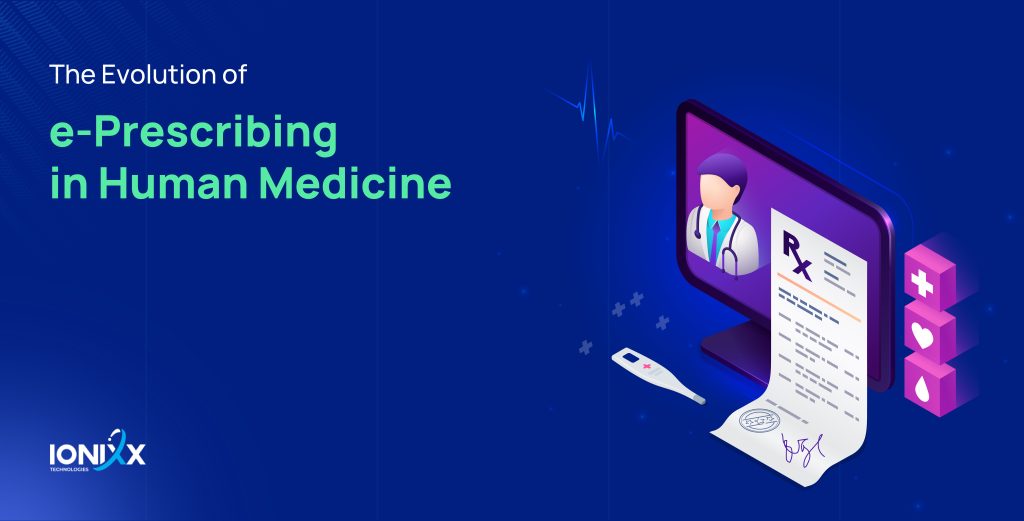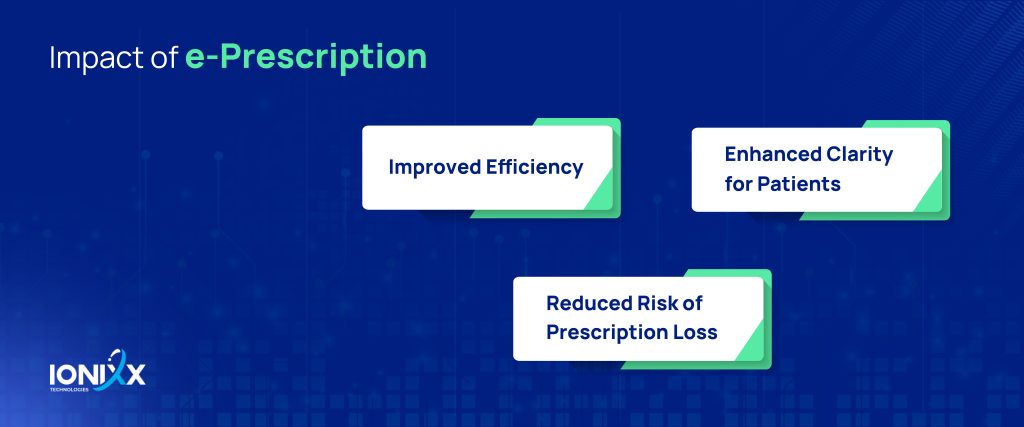
ePrescribing has revolutionized the healthcare sector, with the United States witnessing a significant adoption rate of 80%. Even in rural areas, the implementation of ePrescribing software has opened new doors for digital practices in healthcare. While traditional prescribing methods can be time-consuming, ePrescribing aims to enhance medication management safety, efficiency, and convenience.
This blog summarizes the key takeaways of our recently concluded webinar on the topic, The Evolution, Impact, and Opportunities of ePrescribing with Dr.Maanas Samant, CMIO at Ionixx Technologies.
As an extended reading of this blog, you may watch the webinar on YouTube.
In this blog, we explore the evolution of ePrescribing, its impact on healthcare providers and patients, the challenges faced in real-time implementation of ePresccribing software solutions. We also discuss the future prospects and opportunities that lie ahead in this rapidly evolving field.
Evolution of ePrescribing
The evolution of ePrescribing has brought significant advancements to the healthcare sector, revolutionizing the way prescriptions are processed and managed. Initially met with resistance and skepticism, it has gradually gained acceptance and has become integral to modern healthcare practices. This section will outline the key stages of its evolution, highlighting key drivers, success factors, and advancements that have shaped its growth.
Early Resistance to Change
Unfamilairity with with Electronic Health Records (EHRs) and poorly conceived UX, and concerns regarding integration with other technologies have often been the primary roadblocks to ePrescribing adoption. That has changed with the pressing need for modernization in healthcare systems.
Legislative Push And Incentives
Government legislation and incentives played a vital role in driving the widespread adoption of ePrescribing. The 21st Century Cures Act, enacted in 2016, mandated physicians to electronically prescribe a significant proportion of controlled substances, further pushing for the transition to ePrescribing.
Maturation of ePrescribing Systems
Over time, ePrescribing systems matured, addressing concerns related to interoperability, data security, and user experience. These advancements paved the way for the seamless integration of ePrescribing into healthcare workflows.
Regulatory Catalyst: EPCS (Electronic Prescribing of Controlled Substances)
The introduction of Electronic Prescribing of Controlled Substances (EPCS) served as a regulatory catalyst, facilitating the secure and controlled electronic prescribing of medications with a potential for abuse. EPCS further strengthened the ecosystem, ensuring patient safety and reducing the risk of prescription loss.
Impact And Benefits of ePrescribing

Improved Efficiencies
Studies conducted in 2012 have shown that ePrescribing significantly reduces medication errors, improving patient safety and outcomes. The digital platform streamlines the prescription process, minimizing potential errors associated with handwritten prescriptions.
Enhanced Clarity for Patients
ePrescribing improves clarity for patients by providing legible and standardized prescriptions. This reduces the need for patients to seek clarification, leading to fewer phone calls and increased convenience for both healthcare providers and patients.
Reduced Risk of Prescription Loss
With ePrescribing, the risk of prescription loss is significantly reduced. Prescriptions are securely stored within the digital system, ensuring accessibility and preventing the loss or misplacement of important medication information.
What Are The Challenges in Adopting ePrescribing Practise?
Manual Inputs, And Time-intensive Data Feeds
Implementing the new system requires a significant amount of manual input initially, including entering patient information and updating medication lists. This process can be time-consuming and may pose challenges during the transition phase.
Tedious Data Entry Process
Healthcare providers often face the tedious task of entering detailed information for each prescription, which can be a potential source of frustration and administrative burden.
Data Security And Usability Concerns
Ensuring the security of patient data is paramount in e-prescribing. Robust security measures must be in place to protect sensitive health information. Additionally, usability concerns, such as complex user interfaces or software glitches, can impact the adoption and efficiency of ePrescribing systems.
Specific Training Requirements
To effectively use ePprescribing systems, healthcare providers need comprehensive training to navigate the software and optimize its functionalities. Adequate training programs should be in place to ensure efficient and seamless adoption.
Future and Opportunities
Improved User Interface And Experience
Continued advancements in technology will lead to improved user interfaces and overall user experience, making ePrescribing software more intuitive and user-friendly for healthcare providers.
Advancement in Data Analytics
With the increasing availability of vast healthcare data, data analytics will play a crucial role in leveraging insights to enhance medication management, identify trends, and improve patient outcomes.
Competition and Monopoly
Competition among ePrescribing software providers will drive innovation, leading to better features, functionalities, and pricing options. The breaking down of monopolistic practices will promote a healthy market and spur further advancements.
Using AI in ePrescribing
The integration of Artificial Intelligence (AI) holds immense potential in optimizing ePrescribing systems. AI algorithms can assist healthcare providers in identifying potential drug interactions, allergies, and personalized treatment options, further improving patient safety and medication management.
How Can Ionixx Help with ePrescribing Software Development?
The e-prescribing has transformed the healthcare landscape, offering improved efficiencies, patient clarity, and reduced risks. Despite challenges such as manual input and data security concerns, the future of e-prescribing looks promising.
With a continued focus on safety, efficiency, and convenience, e-prescribing is set to reshape the future of medication management in human medicine. Ionixx offers an excellent solution for the Healthcare domain across the globe.
Our team of healthtech developers seek to elevate the quality of fundamental Medicare services through the use of transformative technology. We work with providers across the entire spectrum of care to build to build healthcare software solutions that bridge the gap between physicians and patients.
Speak to us today.


